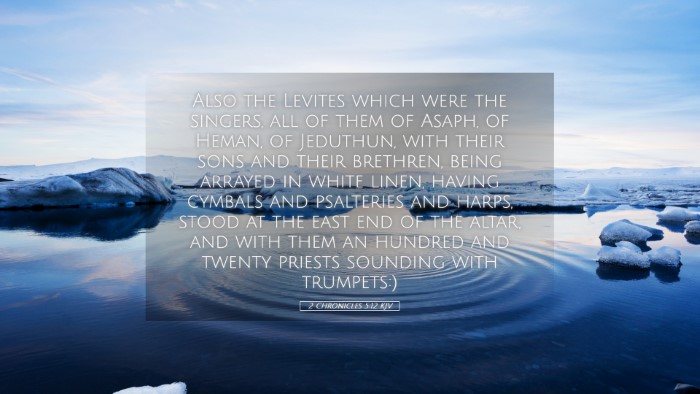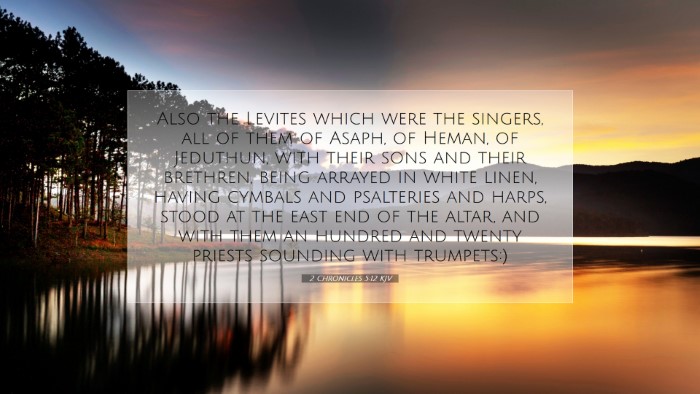Commentary on 2 Chronicles 5:12
2 Chronicles 5:12 states:
"And the Levites which were the singers, all of them of Asaph, of Heman, of Jeduthun, with their sons and their brethren, being arrayed in white linen, having cymbals and psalteries and harps, stood at the east end of the altar, and with them a hundred and twenty priests sounding with trumpets."
This verse is situated within the context of the dedication of Solomon’s Temple, marking a significant moment in Israelite religious history. Commentators provide various insights into its theological, historical, and practical implications.
The Role of the Levites and the Singers
Matthew Henry emphasizes the importance of the Levites' role in worship, highlighting that their arrangement and attire signify their sacred calling.
- Significance of White Linen: The white linen garments worn by the singers symbolize purity and holiness, appropriate for those who are engaged in the service of the Lord. It suggests a separation from mundane activities and a devotion to the divine.
- Unity in Worship: The presence of Levites from different families (Asaph, Heman, Jeduthun), indicates a united front in worship, demonstrating that worship transcends individual backgrounds.
Musical Instruments in Worship
Albert Barnes notes the significance of musical instruments in the context of communal worship.
- Mosque of Joy: The use of cymbals, psalteries, and harps was not merely for aesthetic reasons; music was integral to expressing joy and reverence during the worship service.
- Instruments as Tools of Praise: Barnes underscores the relationship between music and worship, suggesting that musical instruments enhance the atmosphere of reverence and celebration before God.
The Priestly Involvement
Adam Clarke points out the role of the priests in the sacrificial system, noting that their involvement alongside the singers reinforces the connection between praise and sacrifice.
- Cohesion Among Leaders: The harmony between the priests and the Levites indicates a well-coordinated worship service, essential for maintaining order and reverence as they approached God’s presence.
- Spiritual Leadership: Clarke emphasizes that the priests sounding trumpets alongside singers illustrates the importance of spiritual leadership, which invites the congregation into a deeper experience of worship.
Overall Significance of the Moment
This moment signifies the fulfillment of God’s promise to dwell among His people and marks the culmination of Israel’s worship life under Solomon.
- The Covenant Community: The gathering of Levites and priests not only represents a historical moment but also the covenant community’s commitment to communal worship.
- A Shadow of New Covenant Worship: Modern pastors and theologians can draw parallels to worship practices today, reflecting on how community, unity, and preparation continue to be essential elements of worship.
Theological Reflections
This verse invites reflection on the nature of worship and community in the life of faith:
- Worship as Collective Endeavor: The participation of diverse members in worship highlights that worship involves the entire community of faith working together to glorify God.
- Continued Importance of Holiness: The emphasis on purity in worship reminds contemporary believers of the call to holiness as they engage in corporate worship.
Conclusion
In summary, 2 Chronicles 5:12 provides profound insights into the nature of worship, the significance of preparation, and the communal aspect of faith. The careful orchestration of Levites, priests, and music serves as a model for contemporary worship practices, reminding us of the joy and reverence that should characterize our approach to God.


